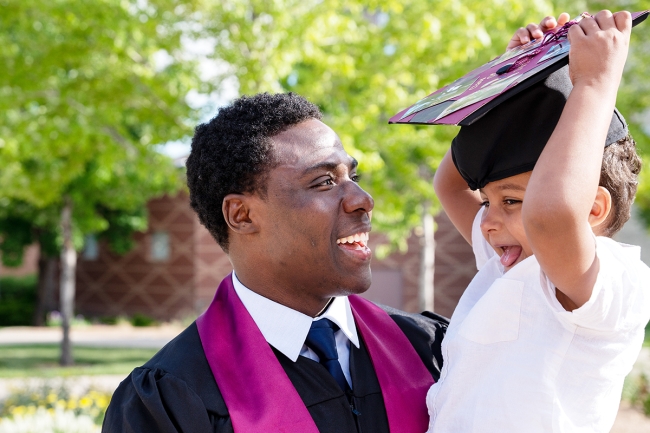You have /5 articles left.
Sign up for a free account or log in.

Black student fathers graduate from college at far lower rates than their peers without children.
Getty Images
Almost 75 percent of Black student fathers withdraw from college before earning a degree. That’s more than double the rate for all undergraduate students (32 percent) and more than 20 percentage points higher than the rate for student parents over all (52 percent).
This disparity is often overlooked because of the larger focus on student mothers, who are a bigger proportion of college students, according to a new analysis by the Center for Law and Social Policy, or CLASP, a nonpartisan research organization.
Christian Collins, a researcher at CLASP and co-author of the report, said although the national conversation on student parents has rightly been focused on mothers, “at the same time, our findings show that student fathers, and specifically Black student fathers, have additional barriers to accessing and completing a postsecondary education that aren’t really highlighted.”
These barriers are being highlighted along with other socioeconomic and structural factors that are increasingly being identified as reasons for decreasing numbers of Black men enrolling in college, or staying and graduating if they do enroll.
According to a report released by the National Student Clearinghouse Research Center in March, enrollment of Black men nationally dropped by 14.3 percent between spring 2020 and spring 2021. The rate plunged even more at two-year colleges—21.5 percent. The decreases were also compounded by the pandemic.
But the trend lines show that their numbers have been falling for some time. About 138,000 fewer Black men enrolled in college last year than in 2017, according to recent news accounts.
And CLASP’s report showed that Black student fathers make up 19 percent of all student parents, who in turn represent 20 percent of the nation’s undergraduate population over all.
The report argues that barriers for student parents, specifically Black student fathers, should be a greater focus point for colleges that market themselves as advocates and engines of socioeconomic mobility. That message aligns with efforts and initiatives at various colleges and universities across the country that are introducing new academic and social support programs for Black men to boost their enrollment and retention on college campuses.
For example, the 116-campus California Community College system has an African American Male Education Network and Development program. Montclair State University launched the Male Enrollment and Graduation Alliance last year.
Still, the findings of the report indicate “that the marketing of the postsecondary system is not meeting the practice,” Collins said. “Outcomes for Black student fathers speak to larger shortcomings and failings for meeting the needs of the students who higher education leaders say benefit the most from a postsecondary education.”
The report, released last week, calls for increased funding and the expansion of federal programs such as the Child Care Development Fund, or CCDF, which provides childcare subsidies to families with low incomes, and Child Care Access Means Parents in School, or CCAMPIS, the only federal grant program specifically designated to support low-income parents who are pursuing postsecondary education. A draft spending plan in the U.S. Senate for the upcoming fiscal year includes a $5 million increase for CCAMPIS, but it’s unclear whether that funding will be supported by House lawmakers.
“It’s important for policy makers to see that a lot of student parents should have an opportunity to pursue postsecondary education, but childcare assistance is a barrier that they’re facing,” said India Heckstall, the other co-author of the report. “In order to help student parents overcome this obstacle, you have to invest in childcare programs.”
Costs and Shortages
The center’s analysis notes “the failure” of the higher ed system in supporting student parents as one contributing factor to the continued decline in postsecondary enrollment by Black men in recent years. As of 2020, nearly 12 million parents in the U.S. held some college credits but no degree or credential.
“For years, we’ve thought of college students as one thing—a recent high school graduate whose parents can support them—but as research has shown, that is not what a traditional student is anymore,” Heckstall said. “We have to rethink our policy of the postsecondary system.”
The report noted two barriers that particularly hinder Black student fathers: the escalating cost of childcare and a shortage of on-campus childcare facilities.
According to data from the National Postsecondary Student Aid Study referenced in CLASP’s report, the cost of childcare rose by about 77 percent for Black student fathers, from $388 per month in the 2011–12 academic year to $686 per month in 2019–20. In comparison, the monthly cost for student parents over all went up by about 42 percent during that same time period.
Collins suggested in some cases this cost gap may be attributable to the lack of childcare options available at the institutions attended by Black student fathers. Only 43 percent of public colleges and 20 percent of historically Black colleges and universities have on-campus childcare available, the report says.
“If there’s only one option available, but it’s really expensive, you don’t really have a choice except to utilize that option,” Collins said.
And while Black student fathers tend to work about four hours more per week than the average student parent, they still end up owing about $2,000 more in student loans, placing them at increased risk of falling into the “educational debt trap,” the report adds.
“It ties to how Black men over all are kind of being siloed into jobs, or professions that aren’t paying as much as their peers, and then coupling on the increase in childcare costs, it leads to them having to rely more on loan services in order to finance their education,” Collins said.
Gender Role Expectations
Antonio Banks, who became the first director of Black and males of color success at Compton College in 2022, said he often hears from students about the frustrations and difficulties of being a student parent in general, but he also sees the “complexities” and “nuances” of being a student father.
For example, one of his student assistants is a Black father who participates in a student family support program called CalWorks. But the student is only one of four men out of about 140 students participating in the program.
“A lot of male parents in particular, I feel like they don’t access those resources, either because of lack of awareness or pride,” Banks said. “Students who don’t fare well, it’s not because of lack of intellect or desire—it’s just not having the navigational capital to understand what resources are available to them by proxy of being a student.”
“So that’s really what we do in our center is getting students connected,” he added.
Shaun Harper, founder and executive director of the University of Southern California’s Race and Equity Center, said even as an educator with expertise on Black male success, he hadn’t considered the experience of Black student fathers through the same framework as the CLASP researchers.
Harper noted that broader sociological factors also play role in Black student fathers’ access to academic and social support programs.
“Fathers are not often thought of as being expected to be caretakers,” he said. “So therefore, even the people who offer childcare options, they tend to market those things for mothers.”
Black fathers have also historically been portrayed in a monolithic, stereotypical manner, he noted.
“There is oftentimes a one-sidedness in the ways that Black fathers are portrayed in the media and perhaps even in research as being absent or not meaningfully involved in their children’s lives. Which, sure, that is the case for some Black fathers,” Harper said. “But it’s certainly not for all of them.”
‘Insufficient’ Funding
The report calls for increased support from Washington.
CCAMPIS, the federal program for student parents, helped roughly 3,300 students who were parents pay for childcare in 2016; 15 percent were Black or African American and 29 percent were men, according to a report by the Government Accountability Office. And of the students participating in the program, the college persistence rate was about 82 percent, the GAO report also showed.
“CCAMPIS doesn’t get enough credit that it’s due. It’s helped a lot of student parents be able to persist and graduate through college,” Heckstall said. “A lot of the funding goes towards community colleges and public institutions and, as we know, community colleges have a lot of low-income students, students of color and things of that nature. So CCAMPIS is a really great program to help students towards completion.”
Theresa Anderson, a principal research associate at the Urban Institute, said such supports are imperative not only in helping Black fathers access and afford childcare during their studies but also in meeting their other basic needs, such as food and housing. (This sentence was revised to remove a characterization of the Urban Institute.)
“Supporting people to increase their education and being able to get better jobs is exactly the thing that is going to allow people to move into self-sufficiency,” Anderson said. “It’s kind of a benefit to everyone across the board.”




